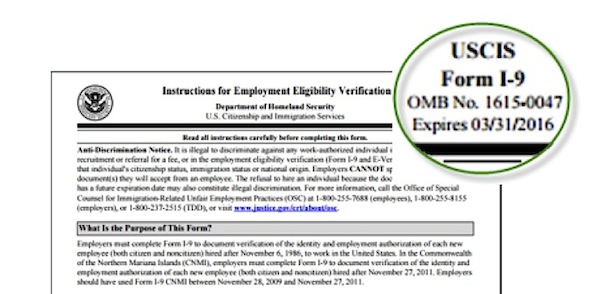
When we first start talking to customers about automating the I-9 and E-Verify process, they want to know what they can do today to become more efficient and improve their level of compliance. These five tips can help organizations in all stages of their I-9 sophistication make immediate improvements and set the stage for future automation.
1. Create and distribute your company’s I-9 & E-Verify policies
Your policy should convey the basic rules which need to be communicated organization wide in order to establish uniformity and accountability. At a minimum, cover these basics:
- An I-9 must be completed
- Signature deadlines
- Document review procedures
- To E-Verify, or not to E-Verify
- To photocopy or not to photocopy all Section 2/3 documents
- Section 3 processing (e.g. Create a new I-9 or complete Section 3 when allowed for rehires)
- Company/industry specific concerns
Here are sample policies to help get you started.
2. Make sure you are completing a current issue version of the Form I-9
There have been eight versions of the Form I-9 to date, with a new form issued about every 4 years. You need to be aware when a new Form I-9 is released. Right now only the 03/31/2016 revision date is valid.

3. Don’t underestimate the importance of training
Putting together a consistent training program is often overlooked. It must take into account employees with various levels of knowledge, new I-9 managers as they come onboard and the impact of program changes when they take place. In our view, there’s no such thing as over-communicating I-9 policies and procedures if you do not have a software system to provide guidance to your employees during the process. A good way to make sure I-9 managers are engaged and understand the importance of their role is to have them read and sign-off on the company’s I-9 and E-Verify policies as well as the I-9 Employer Handbook (M-274).
4. Conduct an audit of your existing paper I-9s
We know it doesn’t sound like fun, but this is an important step to take, on average 50-70% of paper I-9 forms have errors. Once you have committed to the process, determine who, when, and where the audit will take place. Here are some tips for a successful self-audit:
- Compare I-9s with employee roster to identify missing I-9s or I-9s to purge
- Complete new I-9s for those that are missing
- Review I-9s for errors and correct where possible
- Correct I-9s, noting all changes with initials and the date of correction, transparency is key!
- Complete new I-9s for those that are unsalvageable
- Never “backdate” a missing date field
- Do not use white-out to make corrections
- Make a list of lessons learned and conduct Post-Audit Training
5. Go electronic, the benefits speak for themselves
Automating the process is a positive step for organizations of all sizes and industries. The risk is just too high if you remain on paper, not just from a financial/legal standpoint but also when considering the negative publicity that can occur and the overall impact to your brand if something goes wrong. It makes sense to meet with your team and put together your requirements for a solution so when you begin to look at software it is easy to determine if it will meet your needs. The free whitepaper I-9 Eval Guide: Questions You’ll be Glad you Asked is a great tool to help with that.
Tracker is the most trusted partner for I-9 and E-Verify compliance, with thousands of customers including the top U.S. employers. We are the only I-9 software company with a perfect 13-year record with federal agencies and systems. Request a demo of Tracker’s I-9 and E-Verify solution and take the first step toward flawless compliance.